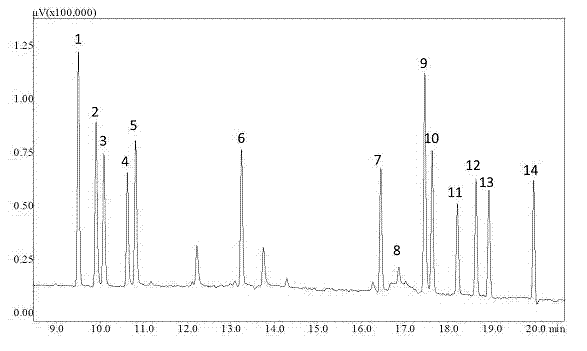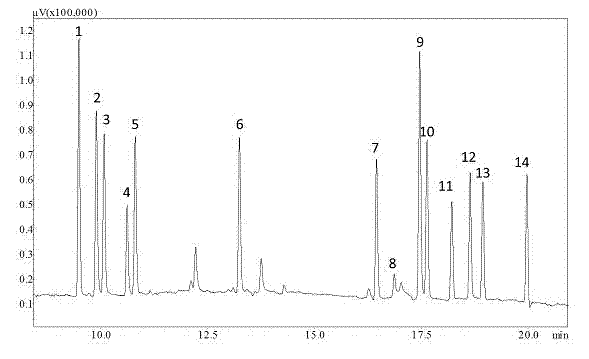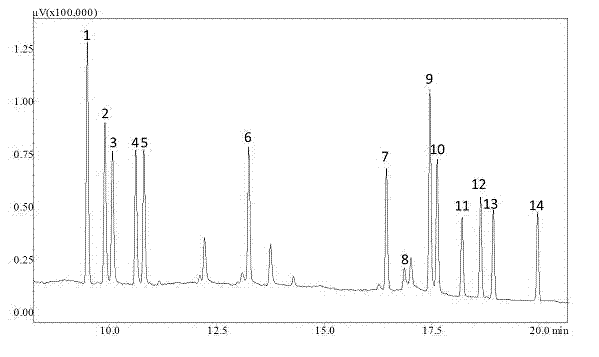Sample pretreatment method for detection of organochlorine pesticide residue in food
A technology for pesticide residue detection and sample pretreatment, which is applied in measurement devices, instruments, scientific instruments, etc., can solve the problems of complex process, cumbersome operation, time-consuming, etc., achieve mild extraction conditions, solve cumbersome operations, and simple operation steps. Effect
- Summary
- Abstract
- Description
- Claims
- Application Information
AI Technical Summary
Problems solved by technology
Method used
Image
Examples
Embodiment 1
[0016] Example 1: Extraction of organochlorine pesticide residues in fish meat
[0017] Weigh 5g of carp back meat that has been homogenized, add 6.5g of water (add water according to the water content of the sample, so that the total water content is 10g, usually the water content of fresh meat is 70%, just add 6.5g of water), and vortex. Three kinds of two-phase aqueous systems were used to extract it: method (1) adding 3.4g potassium acetate and 4g acetonitrile; method (2) adding 4.0g sodium acetate and 4.8g acetonitrile; method (3) adding 2.8g potassium fluoride and 4 g of acetonitrile. Vortex the system for 1min, then centrifuge at 3500rpm for 10min, transfer the supernatant to another centrifuge tube, add 1g of anhydrous magnesium sulfate and 0.1g of PSA solid particles, vortex for 1min, centrifuge at 3500rpm for 10min, and extract at 20-30°C , take the supernatant, gas chromatography sampling detection. Taking method (1) as an example, the chromatogram of the spiked f...
example 2
[0018] Example 2: Detection of organochlorine pesticide residues in eggs
[0019] Discard the shell of the egg, mix the egg white and egg yolk, set aside. Take 10g sample, add 2.5g water (add water according to the water content of the sample, so that the total water content is 10g, usually fresh egg water is 75%, just add 2.5g water), and use three kinds of two-phase system to extract it: Method (1) add 1.9g dipotassium hydrogen phosphate, 2.5g potassium phosphate and 1.6g isopropanol; method (2) add 4.6g dipotassium hydrogen phosphate and 3.0g 1,2-propanediol; method (3) add 7.0g phosphoric acid potassium and 3.0 g 1,2-pentanediol. Vortex for 1min, then centrifuge at 3500rpm for 10min, transfer the upper phase liquid to another centrifuge tube, add 1.5g anhydrous magnesium sulfate and 0.15g C18 solid particles respectively, vortex for 1min, centrifuge at 3500rpm for 10min, the extraction temperature is 20-30℃, Take the supernatant and inject gas chromatography for detectio...
example 3
[0020] Example 3: Detection of organochlorine pesticide residues in milk powder
[0021] Take 1g of milk powder (moisture content of milk powder is less than 5%, which can be ignored), and use three kinds of two-phase systems to extract it: method (1) add 2.0g of water, 0.5g of sodium chloride and 2.5g of acetone; method (2) ) by adding 6g of water, 1.6g of ammonium sulfate and 2.4g of acetone; method (3) by adding 5.5g of water, 0.5g of sodium sulfate and 4.0g of acetonitrile. Vortex for 1 min, then centrifuge at 3500rpm for 10min, transfer the supernatant to another centrifuge tube, add 1g of anhydrous magnesium sulfate and 0.1g of PSA solid particles respectively, vortex for 1min, centrifuge at 3500rpm for 10min, the extraction temperature is 20-30℃, take The supernatant was injected and detected by gas chromatography. Taking method (1) as an example, the chromatogram of the milk powder spiked sample is shown in image 3 , 14 kinds of organochlorine pesticide addition rec...
PUM
 Login to View More
Login to View More Abstract
Description
Claims
Application Information
 Login to View More
Login to View More - R&D
- Intellectual Property
- Life Sciences
- Materials
- Tech Scout
- Unparalleled Data Quality
- Higher Quality Content
- 60% Fewer Hallucinations
Browse by: Latest US Patents, China's latest patents, Technical Efficacy Thesaurus, Application Domain, Technology Topic, Popular Technical Reports.
© 2025 PatSnap. All rights reserved.Legal|Privacy policy|Modern Slavery Act Transparency Statement|Sitemap|About US| Contact US: help@patsnap.com



